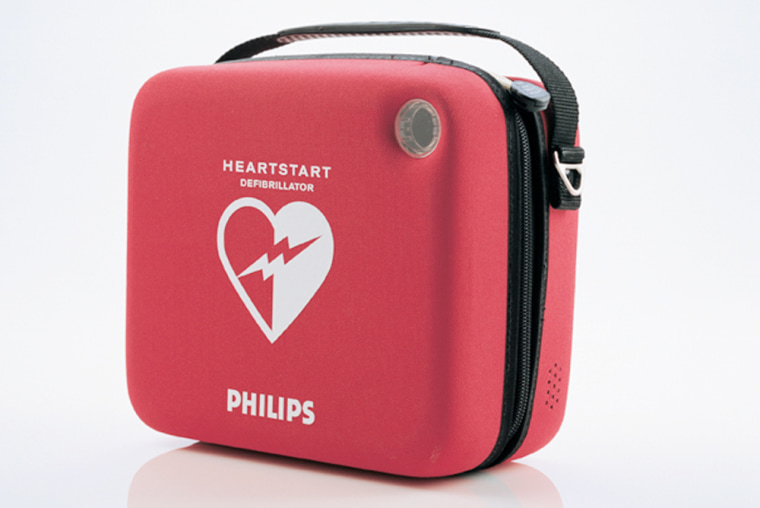Defibrillators that jump-start a stopped heart may save lives in airports and shopping malls, but few people keep them at home in case of collapse — even though that’s where most cardiac arrests occur.
Now a manufacturer hopes to spur sales by making the devices as easy to buy as a fire extinguisher, asking the government to lift its requirement that at-home defibrillators be sold only with a doctor’s prescription.
It’s a controversial issue. Would in-home use of the machines, which cost almost $2,000, save many lives, or instead waste precious minutes if distraught relatives hunted the device instead of dialing 911 first?
“People would be better off spending the money on a health club membership,” says Dr. Thomas H. Lee, a Harvard Medical School cardiologist and editor of the Harvard Heart Letter.
Philips Medical Systems, maker of the HeartStart home defibrillator, argues that consumers deserve to decide but physicians often won’t prescribe the easy-to-use devices.
Over-the-counter sales?
Next week, the Food and Drug Administration’s scientific advisers will debate Philips’ request for over-the-counter sales. FDA’s chief concern is whether ordinary people can figure out proper use on their own.
“I don’t view this as a magical cure for the problem,” says Dr. Jeremy Ruskin, Massachusetts General Hospital’s cardiac arrhythmia chief, a defibrillator proponent helping Philips’ push.
But, “even if five of every 100 cardiac arrest victims are ultimately saved, if there’s ultimately widespread availability we will double the existing survival rate,” he predicts. “The stakes are high.”
Every year, about 220,000 Americans die of cardiac arrest, where the heart’s electrical system goes haywire and heartbeat abruptly stops. Previous heart attacks and other symptoms increase the risk, but in half of cases, cardiac arrest is the victim’s first sign of heart disease.
CPR buys some time, but only a defibrillator can restart the heart, with a jolt of electricity. Every minute spent waiting for a paramedic to arrive with one lowers the chance of survival by 10 percent, and 95 percent of victims die.
Opponents say CPR still best option
Last fall, a major study showed that having portable defibrillators in airports and other public places can double the chances of surviving cardiac arrest.
Yet roughly 80 percent of cardiac arrests occur in the home. A study of 7,000 people, funded by the National Institutes of Health, now is testing whether at-home defibrillators save lives, too. After all, there’s less chance of a collapse being witnessed at home than in a public place, and loved ones may be more likely to panic.
What if people hunt for the defibrillator only to find their loved one isn’t in cardiac arrest, and waste time they could have spent dialing 911 and administering CPR?
“If you took the time and energy to try to teach people to do CPR, it’s far and away going to save more lives than putting defibrillators in everybody’s bathroom,” says Dr. Robert S.D. Higgins, cardiovascular surgery chief at Rush University Medical Center.
“If they were free, I would say fantastic, go pick one up,” adds Harvard’s Lee. “But the overwhelming likelihood is it would never be used.”
'Lying around like a fire extinguisher'
NIH study results aren’t due for several more years, but Philips’ backers counter it’s an issue of consumer choice.
“As a family member, I think you’d want to know you’d done everything possible to help save a loved one’s life,” says Mary Newman of the National Center for Early Defibrillation.
“You want it lying around like a fire extinguisher,” just in case, agrees Timothy Colgan, 52, of Vaughn, Wash. A self-described obese diabetic with high blood pressure, he’s angry that his primary care physician ordered him to see a cardiologist instead of prescribing the defibrillator.
The American Heart Association is cautiously backing over-the-counter sales. It won’t say how many homes really need a defibrillator, but has decided a prescription isn’t necessary to use it properly.
The machine measures heartbeat and won’t deliver a shock unless someone truly is in cardiac arrest. Step-by-step voice instructions guide users, and the machine chirps like a smoke alarm when the four-year battery runs low.
Insurance seldom pays for the $1,995 machine today. Philips, which has sold 5,000 prescription at-home defibrillators since 2002, says the price probably would drop if it could sell more over the counter.
